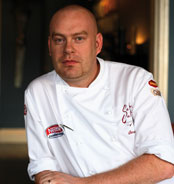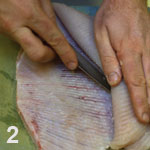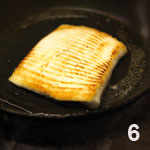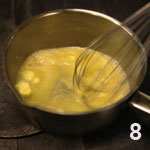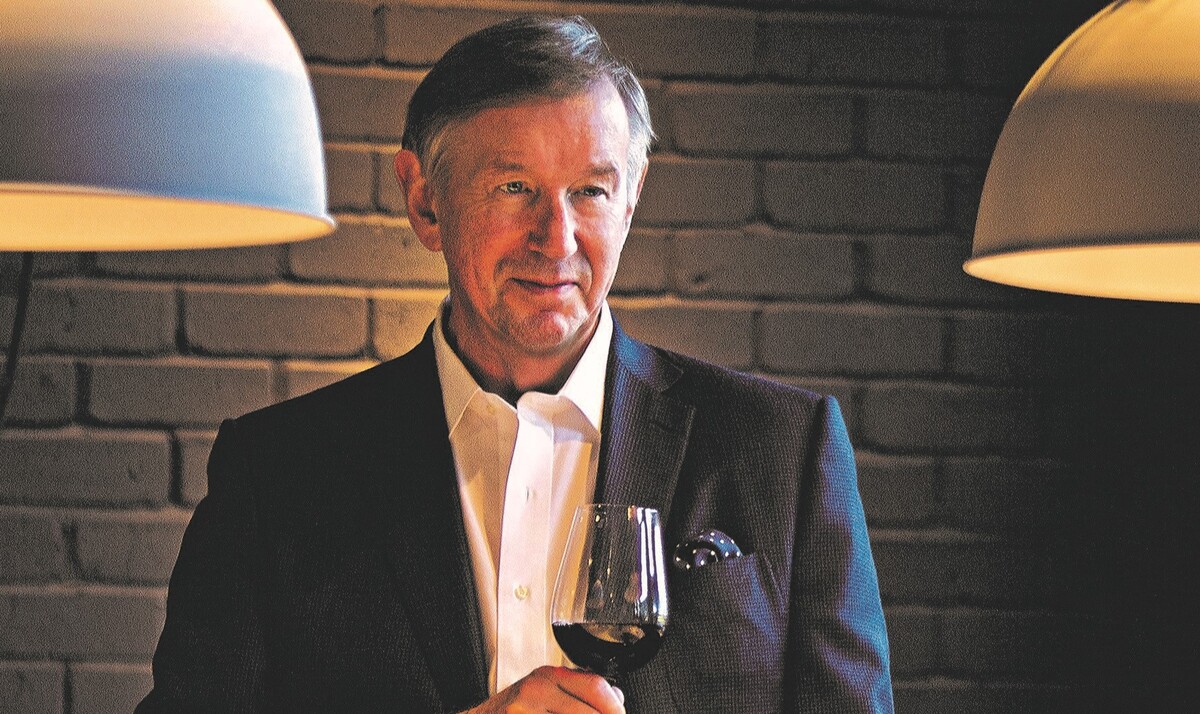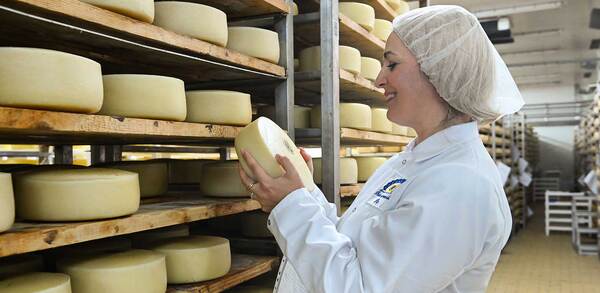Skate – a masterclass
Many chefs treat skate as a one-hit wonder. But Simon Hulstone looks beyond pan-frying it with black or brown butter, as Michael Raffael reports
Pan-fried skate with black or brown butter. It's a classic dish that doesn't age, and any gastropub, bistro or brasserie could put it on the menu and sell it. On a plate it's dished up as an irregular-shaped fish slab, long flakes of white meat held together by a core of cartilage.
But this "look no further" approach undersells a unique fish with taste and texture to rival turbot or sole. In its favour, it costs a third of the price. Against it, few chefs know or have tried working with it. This was once understandable. Skate wings vary from a few ounces to many pounds. They're covered with slimy but armoured skin that's almost impossible for even skilled larder chefs to remove, and it's also hard to portion.
The size question can be answered, however. Record skates and rays tip the scales at 100kg or they can be little more than a few pounds. Although certain species like the common skate are properly protected because they're endangered, there are seven other varieties being landed by inshore fishing boats, providing wings both large and small.
Skin is no longer a problem either, because fish suppliers have machines which remove it for their customers, although portioning needs thinking about if the skate wing is going to be filleted before cooking. At the Elephant, Torquay, Simon Hulstone is right when he claims that few of his customers know how to deal with bones. It's a shame, but it's true. Skate have two fillets, one on the plumper, upper side, and another on the flat underside. To obtain fillets of decent thickness from both, chefs want wings weighing at least 750g.
Filleted and trimmed, skate is in the premier league. It deserves to be treated as a star. Increasingly, chefs around the world from Charlie Trotter to Pierre Gagnaire are recognising its potential.
Simon Hulstone
Cooking at 16, head chef at 21, Simon Hulstone built his reputation the hard way, as a competition chef. He was a Junior World Champion in 1995 while in his teens, again in 1997 and 1998, and has won dozens of awards nationally, including the 2002 Roux Scholar.
This impressive pedigree contrasts with comments from judges at this year's Global Chef Competition held at Tallinn, Estonia, who marked down a dish because it was "too much like restaurant food".
This comment proves that his cooking at the Elephant, Torquay, where with five chefs he cooks for a brasserie and fine-dining room from the same kitchen, isn't just about show. It's practical, cost-effective and good to eat as well as looking fantastic.
Price and yield
At about £5.50 per kg, skinned weight, skate wings are undervalued. The wing Simon Hulstone prepared weighed 900g.
Yield: top fillet 400g bottom fillet 168g.
Portions: three main courses plus trimmings for salad.
Freshness
Skate is highly perishable. It will keep for two to three days at a near-freezing temperature. Bright red or pink traces of blood are an indication of freshness. As soon as the wing starts to smell of ammonia it ceases to be saleable.
Filleting
On board the fishing vessel, fishermen cut out the head and tail of the skate as soon as it's caught, so they land only the wings. An exception is the skate cheeks, but these are, unfortunately a rarity.
Skate wings have no bones, just cartilage running through them in parallel strands. It's covered on both sides with flesh tapering towards the edge of the wings. The upper, dark-skinned side is more than twice as thick as the lower, white-skinned side (1).
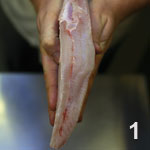
Lay the wing on the work surface with the thicker side uppermost. A raised ridge of cartilage runs along the cut surface. Keeping the edge of the knife flush against it, separate the meat from it (2).
Keeping the blade against the cartilage, lift the flesh from it in a single sheet. When filleting, use a very sharp, relatively flexible knife. Don't saw or hack the fish, because this would damage presentation and texture. Turn over the wing and remove the second fillet (3).
For a main-course portion, square up the meat into 140g-150g portions (4).
To pan-fry skate fillet
Work with wings from larger fish where possible. Bear in mind that the upper fillet is twice the thickness of the lower one. Skate fillet shouldn't be underdone, like tuna, or its unique texture won't be appreciated, but nor should it be overdone or its long, flaky strands of flesh will break up.
The pan has to be hot enough to sear and colour the piece. However, if the heat is too powerful the fillet will curl at the edges and lose its neat appearance.
On the skin side of the fillet, use the tip of a sharp knife to make three or four cuts down grain, following the strands of meat. This will help to keep it flat (5).
Heat 10-15ml (1tbs) pomace olive oil in the pan. Simon Hulstone prefers this to extra virgin oil that might have a bitter taste.
Put the fish, scored side down, in the pan. If the temperature is right it will start sizzling. Fry for three to four minutes - just long enough to colour the surface (6).
Flip the fillet over and take the pan off the heat straight away. Leave to rest for a minute or so latent heat in the pan will finish cooking the skate. Season with Maldon salt, fleur de sel or similar.
Skate with Verjuice, parsnip purée, clams and sweetbreads
Ingredients
(Serves 1)
1 x 150g skate fillet
10 ml pomace
1tsp (heaped) raisins or sultanas soaked in verjuice
20g cooked shelled clams
20g cooked pieces veal sweetbread
50g unsalted butter
10g spring onions, finely sliced
50ml verjuice sauce base
70g approx, creamed hot parsnip purée (250g cooked parsnip, 90g butter, 30g double cream)
Maldon salt
Chervil sprigs
Method
Fry the skate in pomace and reserve.
Heat the drained raisins or sultanas and clams in a little butter. Reheat the sweetbreads in a little butter (7).
Heat the verjuice in a small pan and whisk in the rest of the butter cut into cubes (8), emulsifying the sauce exactly as for a beurre blanc - in practice you would normally be preparing several portions at a time. Check the seasoning.
Stir the spring onion into the clams and raisins.
Spoon the parsnip purée into the middle of the plate and lay the skate fillet on top. Season with salt. Brush with sauce. Arrange the clams and sweetbreads around the fish. Spoon sauce around them (9). Decorate with chervil.
Verjuice sauce base
For the chicken stock
8-10 chicken carcasses
1kg mixed vegetable mirepoix (carrots, shallots, onion, celeriac)
1 bottle dry white wine
Half a head of garlic
1 large bouquet garni
1 litre verjuice
About 1tsp salt
Method
Roast the carcasses and mirepoix in a large roasting tin until they colour.
Deglaze the tin with wine. Boil and reduce almost to a glaze.
Transfer bones, vegetables and jus to a saucepan. Add garlic, the bouquet garni and six litres of water. Boil, skim and simmer for two hours and strain.
Heat one litre of chicken stock with the verjuice and reduce slowly to 300ml. Season lightly then cool and store in a squeezy bottle until required.
Sakte and squab salad
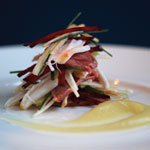
Ingredients
(Serves 1)
1 squab breast (sous-vide 2 hours at 60°C)
50g flaked, sautéd skate trimmings
Chives
3 slices of beetroot, celeriac, Granny Smith apple
2tbs balsamic vinaigrette (three parts olive oil, one part balsamic vinegar)
Maldon salt
1 heaped tsp apple purée
Method
Layer the seasoned, sliced squab breast, skate and chives between a mixed julienne of beetroot, celeriac and apple coated in vinaigrette. Spoon the apple purée to one side.
SKATE AND RAYS
Which Skate?
There's an issue of sustainability with skate that has to be confronted. The common skate is now a protected species and cannot be caught and others are marked for protection. Choose fish caught by day boats where possible.
Endangered species common skate
Overfished and scarce black skate white skate long-nosed skate (these species are protected now)
"Vulnerable" but available for the present blonde ray, 6-10kg
Thornback ray weight usually about 2-4kg, but can be up to 9kg. Landed by day boats, these are ideal from a chef's point of view, but their sustainability needs monitoring
Other rays found in UK waters
- Undulate ray about 5kg
- Cuckoo ray about 1kg, readily available
- Starry ray 2-3kg
- Sandy ray 1-2kg
- Spotted ray similar to the blonde ray but smaller: 3-5kg
Skate on the menu
Simon Hulstone at the Elephant in Torquay
- Skate with verjuice, parsnip purée, clams and sweetbreads
- Skate with cockles and tapioca
- Skate with chorizo, chickpeas and capers
Others
- Terrine de raie (pressed terrine from two-starred Michel Rostang and three-starred Pierre Gagnaire)
- Brochette of langoustines on a tartare of skate (Plezanten Hof, Brussels, Belgium)
- Caramelised skate with winkles, capers and beurre noisette (three-starred Arzak, San Sebastian, Spain)
- Slowly cooked skate wing with fennel frond sorbet, grainy mustard and fennel pollen (Charlie Trotter)
- Fried skate cartilage as a garnish (chef Lieven Putteman)
View all chef jobs on Caterersearchjobs here >>
Photography by Lisa Barber (www.lisabarber.co.uk)


